Google’s Veo 3 Sparks AI Hate Crisis on TikTok: A Wake-Up Call for Content Moderation
Google’s latest AI video generator, Veo 3, was launched in May 2025 with great fanfare. Positioned as a cutting-edge video synthesis model capable of producing hyper-realistic, high-resolution content from text prompts, Veo 3 was touted as a game-changer for creators. But within weeks, the platform became a breeding ground for racist, antisemitic, and dehumanizing content, especially on TikTok.
Despite Google’s and TikTok’s public commitments to fighting hate speech, Veo 3 is now being exploited by users to create and circulate deeply offensive content targeting Black people, Jewish communities, and immigrants. Many of these AI-generated videos bear Google’s unmistakable “Veo” watermark, confirming their origin — and raising uncomfortable questions about tech accountability in the age of generative AI.
🚨 TikTok Flooded With Racist AI Videos from Veo 3
In recent weeks, TikTok has been inundated with short-form AI-generated videos, typically around 8 seconds long, that reinforce harmful racial stereotypes. According to a damning report by Media Matters, several TikTok accounts have posted Veo-generated videos that portray Black people as criminals, absentee fathers, or violent individuals — narratives rooted in long-standing racist tropes.
Even more troubling is the platform’s failure to detect and remove this content before it gains traction. These videos are not simply offensive—they are often designed to skirt content moderation filters through the use of coded imagery and subtle symbolism, making them more difficult to detect.
🤖 Why Google’s Veo 3 Is a Dangerous New Frontier
High Fidelity, Higher Risk
Veo 3’s biggest strength — its ultra-realistic video quality — is becoming one of its biggest dangers. Unlike earlier generative models with cartoonish outputs or limited resolution, Veo 3 creates videos that can pass for real footage, blurring the lines between AI fabrication and actual documentation. This makes the hateful content it generates look more credible, enhancing its viral potential on platforms like TikTok and possibly beyond.
Loopholes in Safety Guardrails
Testing shows that it’s shockingly easy to generate disturbing content using Veo 3 with basic prompts. Users can input slightly veiled racist language or imagery — for example, requesting depictions of “inner city violence” or using monkey imagery in place of Black characters — and the model still produces content without raising red flags.
This suggests that Google’s safety filters and ethical guardrails are either insufficient or too easy to bypass. Unlike its previous models, Veo 3 appears more permissive, giving bad actors a potent new tool to spread harmful narratives under the guise of AI art.
🧠 The Subtlety of AI-Enabled Hate
One of the reasons Veo 3 is so prone to abuse is because racist content can be subtle. AI moderation systems may miss nuanced prompts, metaphors, or culturally specific symbols that encode hateful meaning. For instance:
- Depicting certain ethnic groups in degrading roles (e.g., criminals, homeless, or violent)
- Using animalistic imagery as a racial metaphor
- Including antisemitic symbols that fly under moderation radar
These videos not only slip past the AI’s filters but can also go unnoticed by human moderators unfamiliar with these coded dog whistles. The combination of creative prompt engineering and sophisticated generative output makes it easy to disguise hate in plain sight.
📱 TikTok’s Moderation System: Overwhelmed and Underprepared
Community Guidelines vs. Real-World Outcomes
TikTok’s community guidelines explicitly prohibit hate speech, harassment, and violence against protected groups. Google’s Prohibited Use Policy also bars any use of its tools to facilitate abuse or harassment. Yet, enforcement appears uneven and delayed.
A TikTok spokesperson acknowledged that more than half of the accounts flagged by Media Matters were suspended before the report was published. However, by that point, millions of views had already been racked up. The damage was done.
Moderation at Scale: An Impossible Task?
TikTok uses a mix of automated AI tools and human moderators to police its content. But given the sheer volume of uploads — over 34 million videos per day — identifying and removing offensive videos before they go viral is a Herculean task.
The current system is reactive rather than proactive. By the time racist content is flagged and removed, it has already been downloaded, reshared, and normalized across countless feeds.
🧨 Veo 3 Heading to YouTube Shorts: A Looming Threat
Adding to the concern is the news that Google plans to integrate Veo 3 into YouTube Shorts, its TikTok competitor. While this move makes sense commercially, it also opens another massive platform to abuse by bad actors.
If TikTok’s moderation challenges are any indication, YouTube may struggle to prevent the spread of similar hate-driven content, especially when it originates from its own AI tool.
🏴☠️ Generative AI & Hate Speech: A Worsening Trend
This isn’t the first time generative AI tools have been used to create and disseminate hateful content. From AI-generated racist art on Reddit to deepfake videos targeting women and minorities, creators have always found ways to manipulate these systems — often faster than tech companies can respond.
However, what makes Veo 3 more dangerous is:
- Accessibility: Public access with minimal training needed.
- Believability: The realism of its outputs makes it hard to distinguish AI from real footage.
- Amplification: Platforms like TikTok are optimized for virality, accelerating the spread of harmful material.
🧩 The Real Challenge: Understanding Context and Intent
Contrary to popular belief, the real challenge isn’t technical sophistication — it’s contextual understanding. Today’s AI moderation systems struggle with the nuance of cultural references, sarcasm, coded racism, and historical allusions.
For example, a seemingly innocuous video prompt can take on insidious meaning depending on the racial dynamics it evokes. But without a system capable of understanding social context and intent, AI content generation — and moderation — remains fatally flawed.
⚖️ Platform Responsibility vs. Technological Advancement
The Veo 3 episode exposes a deep tension between innovation and accountability. While Google continues to push the boundaries of what AI can do, it seems to be lagging in ensuring what AI should do.
This raises urgent questions:
- Should AI video generators be released to the public without more robust filters?
- Should AI tools have stricter usage verification (e.g., identity checks)?
- Are current content moderation systems sufficient for the volume and nuance of AI-generated hate?
The answers are murky, but what’s clear is that existing systems aren’t equipped to handle this level of misuse.
📉 What’s at Stake?
For Google:
- Brand damage as Veo 3 becomes associated with hate content
- Regulatory scrutiny, especially from governments focused on AI safety
- Loss of trust in its AI ethics initiatives
For TikTok:
- Failure to moderate could attract renewed calls for bans or regulation, especially in Western markets
- Content moderation fatigue as it fails to keep up with the scale of generative content
For Society:
- Normalization of hate, especially among younger audiences
- Erosion of trust in media, as AI-generated videos become indistinguishable from reality
- Radicalization pipelines, as racist narratives disguised as memes or jokes spread unchallenged
🧠 A Path Forward: Rethinking AI and Moderation Systems

It’s clear that policy alone isn’t enough. Both platforms and AI developers need to rethink their approach to:
1. Proactive Moderation
Rather than waiting for violations, AI systems should flag content that matches high-risk prompt patterns, especially those linked to known stereotypes.
2. Context-Aware AI Filters
Instead of keyword filtering, companies should invest in contextual detection systems that understand cultural nuance, coded language, and implicit bias.
3. Collaborative Audits
AI companies should collaborate with civil rights organizations and content moderation researchers to regularly audit outputs and refine safety guardrails.
4. Transparency Reports
Platforms must publish real-time transparency reports showing how many AI-generated videos are flagged, removed, or go viral despite policy violations.
🧾 Final Thoughts: Technology Without Ethics Is a Dangerous Game
The rise of racist, antisemitic, and harmful content generated by Veo 3 is not just a policy failure — it’s a moral crisis. While generative AI offers immense creative potential, it also opens the door to unprecedented levels of disinformation, radicalization, and digital harm.
If platforms like TikTok and tech giants like Google don’t act decisively, we risk building a digital ecosystem where hate thrives faster than truth — and where the tools meant to create art are instead used to reproduce centuries-old oppression.
Learn Also:

